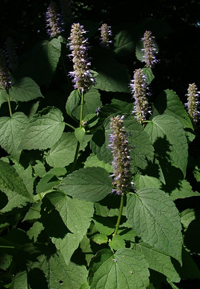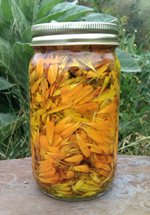As spring quickly turns the corner to summer, flowers everywhere are popping into bloom. Many do more than add color to the landscape. Flowering plants like calendula and anise hyssop also boast healing properties and culinary uses.
At Queens County Farm Museum in Floral Park, agricultural director Kennon Kay is a herb enthusiast. She notes that the working farm’s 47 acres produce a wide variety of useful herbs, including bergamot, catnip, chamomile, echinacea, lavendar, yarrow and lemon balm. In particular, Kay favors calendula and anise hyssop, two perennials that appear every year around the farm.
Calendula, also known as pot marigold, is a short, bushy plant with yellow or orange flowers that look similar to daisies. “They like a lot of sunshine, but actually they’re pretty hardy little plants,” says Kay. “It’s cultivated, but in places like California, where I have farmed in the past, it actually became a weed because it’s a perennial. Here, we have cold enough winters that it keeps it at bay, but it does reseed itself and it’s always a nice surprise when you see them coming up in springtime.” She adds that, as a nod to its common name, the plant grows well in containers. 
Calendula petals are edible and are commonly used in salads. The plant is also used to in oils or salves to treat rashes, skin irritation, and to prevent scarring. Kay says that it’s surprisingly easy to make a calendula-infused oil or salve. Her instructions for creating a calendula salve are below.
A leafy plant with purple flowers, anise hyssop is a useful herb that Kay often brings to area farmers markets. (Queens County Farm Museum operates its on-site farm stand every Wednesday from June to October. It is also participates in the New Amsterdam Farmers Market and can be found at the Union Square farmers market on Fridays.)
Anise hyssop has a distinctive sweet licorice flavor. “We always...have people try it, and they’re always really amazed at how strong the flavor is,” says Kay. “Some people will cut it really finely and will add it to fruit salad. Just a little bit will go a long way.”
Anise hyssop is related to mint and, like calendula, grows well in containers. It shares the stomach-calming, stress-relieving qualities for which mint is well known. Unlike mint, though, it’s not as aggressive and isn’t as liable to jump the pot or spread like a weed.
“A lot of mornings, we’ll just stuff a jar full and pour water over the fresh leaves and leave it in the sun,” says Kay. “And by lunchtime, we’ll have a sun tea that’s pretty mild and has a nice flavor to it.” Lemon and a dollop of honey are also nice compliments to the drink.
Calendula Salve 
1. Fill a mason jar with dried calendula flowers and cover them completely with oil (olive, almond, jojoba). Screw the lid on the jar and place it in a warm spot out of direct sunlight (I put the jar in a brown paper bag and then set it on my windowsill).
2. Leave the oil to infuse for 2-3 weeks.
3. Strain and save the oil.
4. To make the salve, place the oil in a double boiler and add ¼ cup grated beeswax to every 1 cup of oil. Gently warm the oil until all the beeswax has melted. Remove from heat and pour into sterilized containers. Once it cools it will become solid and can be used as a salve.